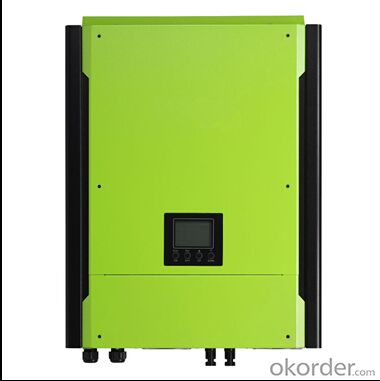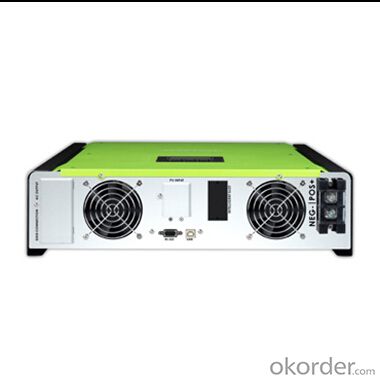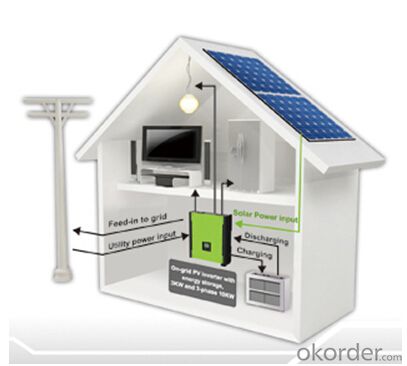On-Grid Energy Storage PV Inverter PH500 Series 1-phase 2KW
- Loading Port:
- China main port
- Payment Terms:
- TT or LC
- Min Order Qty:
- 60000 watt
- Supply Capability:
- 16000000 watt/month
OKorder Service Pledge
OKorder Financial Service
You Might Also Like
1. Structure of On-Grid Energy Storage PV Inverter Description
On-Grid Energy Storage PV Inverter is a hybrid inverter which combines solar system, AC utility, and battery power source to supply continuous power• It is suitable for the remote areas where the cost of utility is too high or emergency usage when utility is not stable.
2. Main Features of the On-Grid Energy Storage PV Inverter
• 2KW on-grid inverter with energy storage
• Pure sine wave output
• Microprocessor controlled to guarantee stable charging system
• Multiple operations: Grid tie, Off grid, and grid-tie with backup
• Built-in MPPT solar charger
• LCD display panel for comprehensive information
• Multiple communication
• Green substitution for generators
• User-adjustable battery charging current
3. On-Grid Energy Storage PV Inverter Images



4. On-Grid Energy Storage PV Inverter Specification
Model | PH500 Single-phase 2KW |
RATED POWER | 2000 W |
GRID-TIE OPERATION | |
PV INPUT (DC) | |
Maximum DC Power | 2250W |
Nominal DC Voltage / Maximum DC Voltage | 300 VDC / 350 VDC |
Start-up Voltage / Initial Feeding Voltage | 80 VDC / 120 VDC |
MPP Voltage Range | 150 VDC ~ 320 VDC |
Number of MPP Trackers / Maximum Input Current | 1 / 1 x 15 A |
GRID OUTPUT (AC) | |
Nominal Output Voltage | 101/110/120/127 VAC |
Output Voltage Range | 88 - 127 VAC* |
Nominal Output Current | 18 A |
Power Factor | > 0.99 |
EFFICIENCY | |
Maximum Conversion Efficiency (DC/AC) | 0.95 |
European Efficiency@ Vnominal | 0.94 |
OFF-GRID OPERATION |
|
AC INPUT | |
AC Start-up Voltage/Auto Restart Voltage | 60 - 70 VAC / 85 VAC |
Acceptable Input Voltage Range | 85 - 130 VAC* |
Number of MPP Trackers / Maximum Input Current | 30 A |
PV INPUT (DC) | |
Maximum DC Voltage | 350 VDC |
MPP Voltage Range | 150 VDC ~ 320 VDC |
Maximum Input Current | 1 / 1 x 15 A |
BATTERY MODE OUTPUT (AC) | |
Nominal Output Voltage | 101/110/120/127 VAC |
Output Waveform | Pure Sinewave |
Efficiency (DC to AC) | 0.9 |
HYBRID OPERATION | |
PV INPUT (DC) | |
Nominal DC Voltage / Maximum DC Voltage | 300 VDC / 350 VDC |
Start-up Voltage / Initial Feeding Voltage | 80 VDC / 120 VDC |
MPP Voltage Range | 150 VDC ~ 320 VDC |
Maximum Input Current | 1 / 1 x 15 A |
GRID OUTPUT (AC) | |
Nominal Output Voltage | 101/110/120/127 VAC |
Output Voltage Range | 88-127 VAC |
Nominal Output Current | 18 A |
AC INPUT | |
AC Start-up Voltage/Auto Restart Voltage | 60 - 70 VAC / 85 VAC |
Acceptable Input Voltage Range | 80 - 130 VAC* |
Maximum AC Input Current | 30 A |
BATTERY MODE OUTPUT (AC) | |
Nominal Output Voltage | 101/110/120/127 VAC |
Efficiency (DC to AC) | 0.9 |
BATTERY & CHARGER | |
Nominal DC Voltage | 48 VDC |
Maximum Charging Current | 25A |
GENERAL | |
PHYSICAL | |
Dimension, D x W x H (mm) | 420 x 415 x 170 |
Net Weight (kgs) | 15.5 |
INTERFACE | |
Communication Port | RS-232/USB |
Intelligent Slot | Optional SNMP, Modbus, and AS-400 cards available |
ENVIRONMENT | |
Humidity | 0 ~ 90% RH (No condensing) |
Operating Temperature | 0 to 40°C |
Altitude | 0 ~ 1000 m** |
5. FAQ of On-Grid Energy Storage PV Inverter
Q1. What is the difference between inverter and On-Grid Energy Storage PV Inverter?
A1. Inverter only has AC inpput, but On-Grid Energy Storage PV Inverter both connect to AC input and solar panel, it saves more power.
Q2. What is the difference between MPPT&PWM?
A2. MPPT has higher efficiency, it can track the max power point and won't waste energy.
Q3. What is the waranty of product?
A3. 12 months.
- Q:How does a grid-tied solar inverter work?
- A grid-tied solar inverter works by converting the direct current (DC) electricity generated by the solar panels into alternating current (AC) electricity that can be used to power household appliances and be fed back into the electrical grid. It synchronizes the frequency and voltage of the solar-generated AC electricity with that of the grid, allowing seamless integration and transfer of power. This inverter also ensures safety by monitoring the grid connection and automatically disconnecting the solar system from the grid during power outages or maintenance work. Overall, it enables efficient utilization of solar energy and allows homeowners to reduce their reliance on fossil fuels while potentially earning credits for excess electricity generated.
- Q:How does a solar inverter impact the overall system reliability?
- A solar inverter plays a crucial role in ensuring the overall system reliability of a solar power system. It converts the direct current (DC) generated by solar panels into alternating current (AC) that is suitable for use in homes or businesses. By efficiently converting the energy and maintaining optimal voltage and frequency levels, the inverter ensures that the system operates reliably and consistently. It also provides various protective functions, such as monitoring and controlling the system's performance, detecting faults or abnormalities, and shutting down the system in case of emergencies. Therefore, a well-functioning solar inverter significantly impacts the overall system reliability by maximizing energy production, preventing damage, and ensuring smooth operation.
- Q:PV grid-connected inverter and independent inverter in the control of what is the difference
- And you said that the independent inverter, said off-grid inverter it, this inverter can not access the mains, the components of the electricity through the off-grid inverter to the battery charge, the battery at night
- Q:Can a solar inverter be used in regions with high levels of air pollution?
- Yes, a solar inverter can be used in regions with high levels of air pollution. The performance of the solar inverter may be slightly affected due to the reduced sunlight reaching the solar panels, but it can still convert the available solar energy into usable electricity. Regular maintenance and cleaning of the solar panels may be required to mitigate the impact of air pollution on their efficiency.
- Q:How does a solar inverter handle grid faults and disturbances?
- A solar inverter is designed to handle grid faults and disturbances by continuously monitoring the grid conditions. In the event of a fault or disturbance, such as a voltage or frequency fluctuation, the solar inverter will quickly disconnect from the grid to ensure the safety of the system. Once the fault is resolved and the grid conditions stabilize, the solar inverter will reconnect to the grid and resume normal operation, ensuring a reliable and stable power supply.
- Q:Can a solar inverter be used in a hybrid solar system?
- Yes, a solar inverter can be used in a hybrid solar system. A hybrid solar system combines both solar energy and another source of energy, such as a battery or grid power. The solar inverter is responsible for converting the DC (direct current) power generated by the solar panels into AC (alternating current) power that can be used to power the electrical devices in a home or business. In a hybrid solar system, the solar inverter can still perform this function, allowing the system to utilize solar energy while also being able to draw power from other sources when needed.
- Q:Can a solar inverter be used with different types of tracking systems?
- Yes, a solar inverter can be used with different types of tracking systems. The function of a solar inverter is to convert the DC (direct current) generated by the solar panels into AC (alternating current) that can be used to power electrical devices. As long as the tracking system is capable of generating DC power from the solar panels, the solar inverter can be used to convert it into usable AC power.
- Q:How does a solar inverter handle fluctuations in solar panel output due to temperature changes?
- A solar inverter handles fluctuations in solar panel output due to temperature changes by employing a maximum power point tracking (MPPT) algorithm. This algorithm continuously monitors the output of the solar panels and adjusts the operating conditions of the inverter to extract the maximum power available. As temperature changes, the MPPT algorithm adapts the inverter's parameters to optimize the energy conversion process and ensure the highest possible efficiency. By dynamically adjusting the voltage and current levels, a solar inverter effectively mitigates the impact of temperature fluctuations on the solar panel's output.
- Q:Can a solar inverter be used with a solar-powered lighting system?
- Yes, a solar inverter can be used with a solar-powered lighting system. The solar inverter is responsible for converting the direct current (DC) generated by the solar panels into alternating current (AC) that can be used to power the lighting system. It ensures efficient energy conversion and ensures compatibility between the solar panels and lighting system.
- Q:What is the role of MPPT (Maximum Power Point Tracking) in a solar inverter?
- The role of MPPT (Maximum Power Point Tracking) in a solar inverter is to optimize the power output from a solar panel by continuously tracking and adjusting the operating point to ensure it operates at the maximum power point. This is crucial because the power output of a solar panel is affected by various factors such as temperature and shading, and without MPPT, the inverter would not be able to extract the maximum power from the panel, leading to reduced efficiency and output. MPPT algorithms monitor the voltage and current of the solar panel and adjust the load to match the optimal operating voltage, maximizing the power output and overall system performance.
1. Manufacturer Overview |
|
|---|---|
| Location | |
| Year Established | |
| Annual Output Value | |
| Main Markets | |
| Company Certifications | |
2. Manufacturer Certificates |
|
|---|---|
| a) Certification Name | |
| Range | |
| Reference | |
| Validity Period | |
3. Manufacturer Capability |
|
|---|---|
| a)Trade Capacity | |
| Nearest Port | |
| Export Percentage | |
| No.of Employees in Trade Department | |
| Language Spoken: | |
| b)Factory Information | |
| Factory Size: | |
| No. of Production Lines | |
| Contract Manufacturing | |
| Product Price Range | |
Send your message to us
On-Grid Energy Storage PV Inverter PH500 Series 1-phase 2KW
- Loading Port:
- China main port
- Payment Terms:
- TT or LC
- Min Order Qty:
- 60000 watt
- Supply Capability:
- 16000000 watt/month
OKorder Service Pledge
OKorder Financial Service
Similar products
New products
Hot products
Hot Searches
Related keywords






























